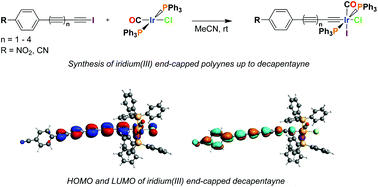Selective synthesis of iridium(iii) end-capped polyynes by oxidative addition of 1-iodopolyynes to Vaska's complex†
Abstract
The reaction of bis(triphenylphosphine)iridium(I) carbonyl chloride (Vaska's complex) with a series of 1-iodopolyynes (1-CnI and 2-CnI) gave σ-polyynyl iridium(III) complexes with general formula R(C![[triple bond, length as m-dash]](https://www.rsc.org/images/entities/char_e002.gif) C)nIr(PPh3)2(Cl)(I)(CO). The use of acetonitrile as a solvent appeared crucial and allowed selectively obtaining only one from a few possible isomers. The X-ray single crystal diffraction experiment for 2-C4[Ir]I allowed the determination of the exact structure of this complex. Further spectroscopic measurements, especially 31P NMR, confirmed the formation of the same type of isomers with trans coordinated phosphines in each case. All complexes were fully characterized with the use of NMR (1H, 13C and 31P), IR, UV/Vis, cyclic voltammetry and (ESI)HRMS techniques. Moreover, DFT calculations were performed for all the resulting species. The complexes with a linear carbon chain from butadiyne to decapentayne are the longest iridium end-capped polyynes known to date since only compounds with a (C
C)nIr(PPh3)2(Cl)(I)(CO). The use of acetonitrile as a solvent appeared crucial and allowed selectively obtaining only one from a few possible isomers. The X-ray single crystal diffraction experiment for 2-C4[Ir]I allowed the determination of the exact structure of this complex. Further spectroscopic measurements, especially 31P NMR, confirmed the formation of the same type of isomers with trans coordinated phosphines in each case. All complexes were fully characterized with the use of NMR (1H, 13C and 31P), IR, UV/Vis, cyclic voltammetry and (ESI)HRMS techniques. Moreover, DFT calculations were performed for all the resulting species. The complexes with a linear carbon chain from butadiyne to decapentayne are the longest iridium end-capped polyynes known to date since only compounds with a (C![[triple bond, length as m-dash]](https://www.rsc.org/images/entities/char_e002.gif) C)2 structural motif have been reported so far. Moreover, we confirmed that the synthetic approach, first used for palladium(II) end-capped polyynes, may be also applied for the synthesis of other structurally new organometallic polyynes.
C)2 structural motif have been reported so far. Moreover, we confirmed that the synthetic approach, first used for palladium(II) end-capped polyynes, may be also applied for the synthesis of other structurally new organometallic polyynes.



 Please wait while we load your content...
Please wait while we load your content...